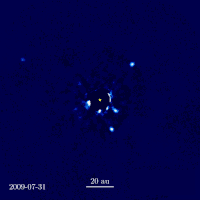
Photo from wikipedia
Direct imaging of gas giant exoplanets provides information on their atmospheres and the architectures of planetary systems. However, few planets have been detected in blind surveys with direct imaging. Using… Click to show full abstract
Direct imaging of gas giant exoplanets provides information on their atmospheres and the architectures of planetary systems. However, few planets have been detected in blind surveys with direct imaging. Using astrometry from the Gaia and Hipparcos spacecraft, we identified dynamical evidence for a gas giant planet around the nearby star HIP 99770. We confirmed the detection of this planet with direct imaging using the Subaru Coronagraphic Extreme Adaptive Optics instrument. The planet, HIP 99770 b, orbits 17 astronomical units from its host star, receiving an amount of light similar to that reaching Jupiter. Its dynamical mass is 13.9 to 16.1 Jupiter masses. The planet-to-star mass ratio [(7 to 8) × 10−3] is similar to that of other directly imaged planets. The planet’s atmospheric spectrum indicates an older, less cloudy analog of the previously imaged exoplanets around HR 8799. Description Astrometry guides imaging detection Direct imaging of exoplanets is challenging because of the glare of the much brighter host star. The technique has detected only small numbers of gas giant exoplanets on wide orbits. Astrometry, the precise measurements of stellar positions, could potentially identify stars being pulled by the gravity of a nearby planet. Currie et al. used astrometry to identify a candidate host star, which they then studied with direct imaging. They found an object with the right properties to explain the astrometry signal and interpreted it as an exoplanet of about 14 Jupiter masses. The detection shows how astrometry can help to detect and characterize directly imaged exoplanets. —KTS Combining direct imaging and astrometry techniques identifies a gas giant exoplanet orbiting a nearby star.
Journal Title: Science
Year Published: 2022
Link to full text (if available)
Share on Social Media: Sign Up to like & get
recommendations!